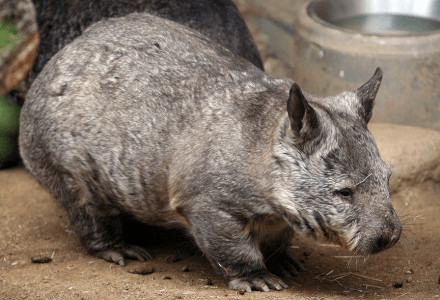
Photo Credit: ZakVTA
CC License: https://bit.ly/1hYHpKw
Northern Hairy-Nosed Wombat Facts
- Most notably, the IUCN currently lists the Northern Hairy-Nosed Wombat as one of the rarest animals on earth. This extremely remarkable marsupial therefore holds the lamentable status of Critically Endangered. This status currently appears on the organization’s published Red List of Threatened Species. The animal further forms one of only three known species of Wombat in the world.
- In addition, this truly amazing creature also deserves recognition for yet another unique status that it presently holds. That’s due to the surprising fact that the remarkable animal also currently ranks as the largest known herbivorous mammal that burrows. The creature further shares this trait with the other known types of Wombat. The animal also sometimes goes by other common names in its area.
- Finally, though its numbers remain extremely dangerously low, in recent years it appears to be making a slight comeback. However, it still faces serious threats to its continued existence. For one, its extremely small habitat range renders it vulnerable to such natural threats as habitat loss. However, the amazing Northern Hairy-Nosed Wombat also now faces the ongoing threat of climate change.
Related Articles
Quokka Tree Kangaroo Sugar Glider
Photo Credit: ZakVTA
CC License: https://bit.ly/1hYHpKw
The Northern Hairy-Nosed Wombat Physical Description
Firstly, a fully mature Northern Hairy-Nosed Wombat occasionally reaches a length of 39 in (1 m). Further, individuals also occasionally weighs up to an incredible 77 lb (35 kg). Additionally, although it does display sexual dimorphism, it does so in an unusual way. That’s because, unlike most mammals the female of this species usually grows slightly larger than the male.
Given that it has two closely related species, many similarities quite understandably exist between them. As a result of this, similar to the two other known varieties of wombat, it has a short tail. Likewise, it also develops a comparatively strongly stocky body shape. In addition, its legs, while proportionately quite short, develop as relatively strong.
In addition, it develops other admirable physical attributes. That’s partly due to the fact that the head develops large. But this also holds true because the head also displays highly pointed ears and tiny eyes. Therefore, the eyesight of the Northern Hairy-Nosed Wombat remains extremely poor. However, its highly developed sense of smell easily compensates for this.
- Kingdom: Animalia
- Phylum: Chordata
- Class: Mammalia
- Order: Diprotodontia
- Family: Vombatidae
- Genus: Lasiorhinus
- Species: L. krefftii
Photo Credit: Chermundy
CC License: https://bit.ly/3CCNJJx
Northern Hairy-Nosed Wombat Distribution, Habitat, and Ecology
The remarkable Northern Hairy-Nosed Wombat has an extremely specific habitat range. That’s because, to the knowledge of experts, the creature currently only inhabits a 300 hectare (741 acres). This area further consists of a portion of the Epping Forest National Park, in Queensland, Australia.
Furthermore, even within the park, the remarkable animal has particular preferences for the areas in which it appears. Typically, though, it inhabits either gum tree acacia woodlands or semi-arid sandy grasslands. There, the lovely creature generally spends most of its days deep in its large burrow.
The fabulous Northern Hairy-Nosed Wombat also remains primarily nocturnal in nature. Nevertheless, it will occasionally sun itself outside its burrow during the day. These same burrows typically serve as home to multiple individuals. This population commonly equals up to 10 individuals.
Finally, the magnificent animals evolved as completely herbivorous in its feeding habits. Therefore, its diet consists principally of the various roots and coarse grasses found within the Park. But, it also occasionally supplements this with various roots native to the region, like the grasses.
Species Sharing Its Range
Cassowary Mary River Turtle Dingo
Check out our other articles on 6 Extremely Localized Invertebrates, Kakapo, Dwarf Sperm Whale, Red Beach, Pinta Island Tortoise, Coral Pink Sand Dune Beetle, Icicle Mushroom

